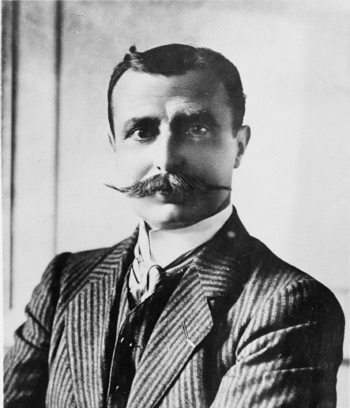Louis Bleriot

Louis Bleriot born 1st July 1872 in Deheries, France. An aviator, engineer and inventor. Mainly known for the first complete heavier-than-air flight over a large body of water, the English Channel in 1909. Louis Bleriot is also credited as being the first person to make a working monoplane and also the pioneer of the sport of air racing.
In his younger days Louis Bleriot studied engineering at Ecole Centrale Paris, where he invented automobile headlights and went on to set up his own acetylene headlamp business, which became very successful. He next went on to experimentation of towed gliders on the Seine River with the money he had gained from the headlamp business. Bleriot furthered his interested in aviation by next developing a ornithopter in 1900, but it failed to take off. Around 1903 Louis Bleriot and Gabriel Voisin joined together to create the Bleriot-Voisin Company. With several unsuccessful and potentially dangerous aircraft designs the company's finances were drained. Bleriot decided to leave the company and attempt some of his own designs and experimenting with various configurations, eventually creating the world's first successful monoplane, the Bleriot V. Unfortunately this model crashed quite easily. In 1909 he created the Bleriot XI, which proved to be far more stable.
There is a memorial to Louis Bleriot near the cliffs above Dover which is on the site he landed after crossing the Channel.
The Channel Crossing
On 25th July 1909 the Bleriot XI was immortalised when Louis Bleriot successfully managed to cross the English Channel in a race from Calais to Dover in 36.5 minutes. Bleriot and his opponents Hubert Latham and Count de Lambert could not fly for several days due to bad weather conditions.
Hubert Latham flew an Antoinette Monoplane and Count de Lambert a Wright Biplane.
The morning of the race when Bleriot woke, it is said that Latham had overslept. During the race Bleriot encountered bad weather including fog and did not even have a compass to guide him across the Channel. The Anzani engine managed to survive the race whole due to the fact that the rain had cooled the engine. As Bleriot approached the English coast he could see a French reporter waving the French flag, this marked his landing spot. The landing gear collapsed due to a pancake landing by Bleriot, but he still walked away with the £1000 prize money which was awarded by the London Daily Mail.
Later life
With over 800 aircraft being produced between 1909-1914, some of which were deemed controversial after inspections after a number of crashes, the British government placed a temporary ban on them. Bleriot himself investigated and solved the problems which had caused these crashes.
In 1913 a consortium led by Bleriot bought the Societe pour les Appareils Deperdussin Airplane manufacturer, of which he became the president of the company in 1914. Bleriot then renamed it to Societe Pour L'Aviation et ses Derives (SPAD), it went on to manufacture a number of World War I fighter planes, including the SPAD S.XIII.
Bleriot tried to set up a British subsidiary via the Bleriot Manufacturing Aircraft Company Ltd in England in 1916. Its listing was hijacked by a dishonest syndicate headed by Harry John Lawson. During 1917 Bleriot tried again and built a factory in Addlestone in Great Britain. Bleriot formed his own company called Bleriot-Aeronautique, which was used for the development of commercial aircraft. It was more successful than the Wright Brothers Company.
A legal patent battle underwent in the United States for the invention of the aileron, this was between Bleriot and the Wright Brothers. The Wright Brothers never received any royalties from Bleriot even though they created it.
Posthumous
In 1936 the Louis Bleriot medal was established by the Federation Aeronautique Internationale. The medal is awarded for speed, altitude and distance records for light aircraft.
In 2002, English train company Virgin Trains named one of their new trains, a British Rail Class 221 after Louis Bleriot.
Rivendell Bicycle Works introduced a bicycle model named the Bleriot 650B in 2006. It has a portrait to Louis Bleriot on the seat tube.
On 25th July 2009, the centenary of the Channel Crossing, Frenchman Edmond Salis took off from Bleriot Beach in an exact replica of the original Bleriot Monoplane and landed at Duke of York's Royal Military School in Kent.




